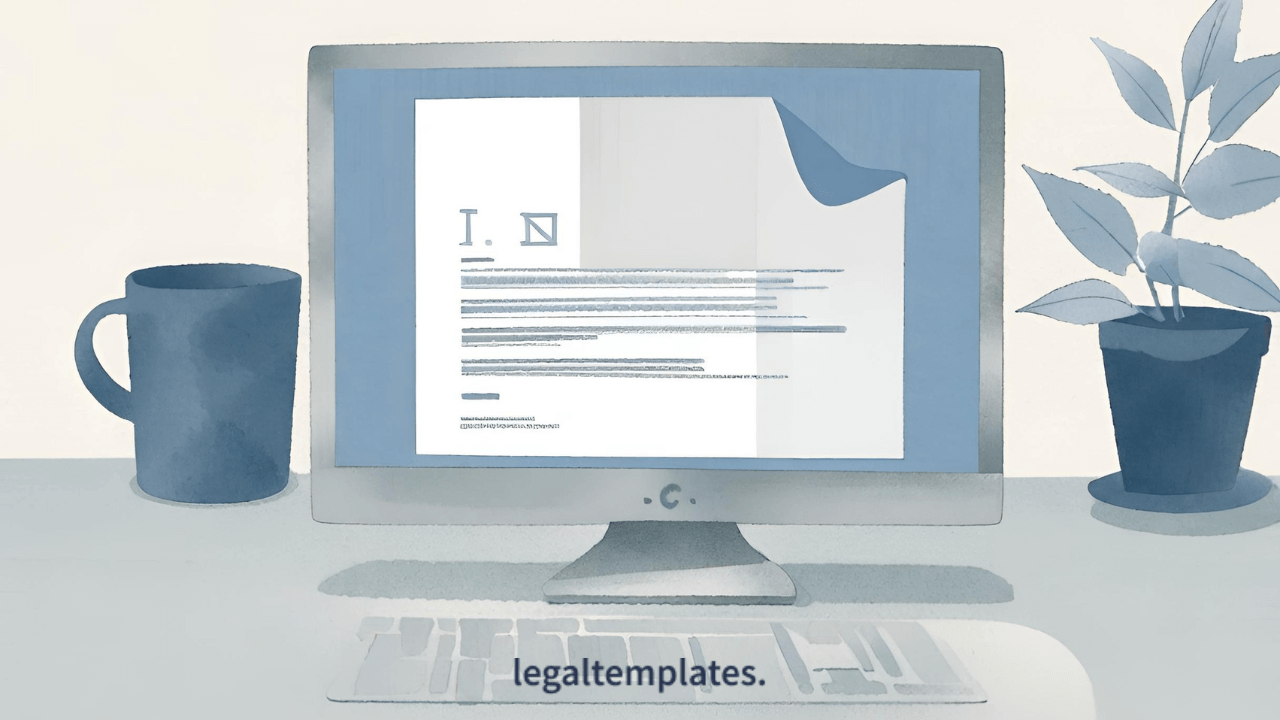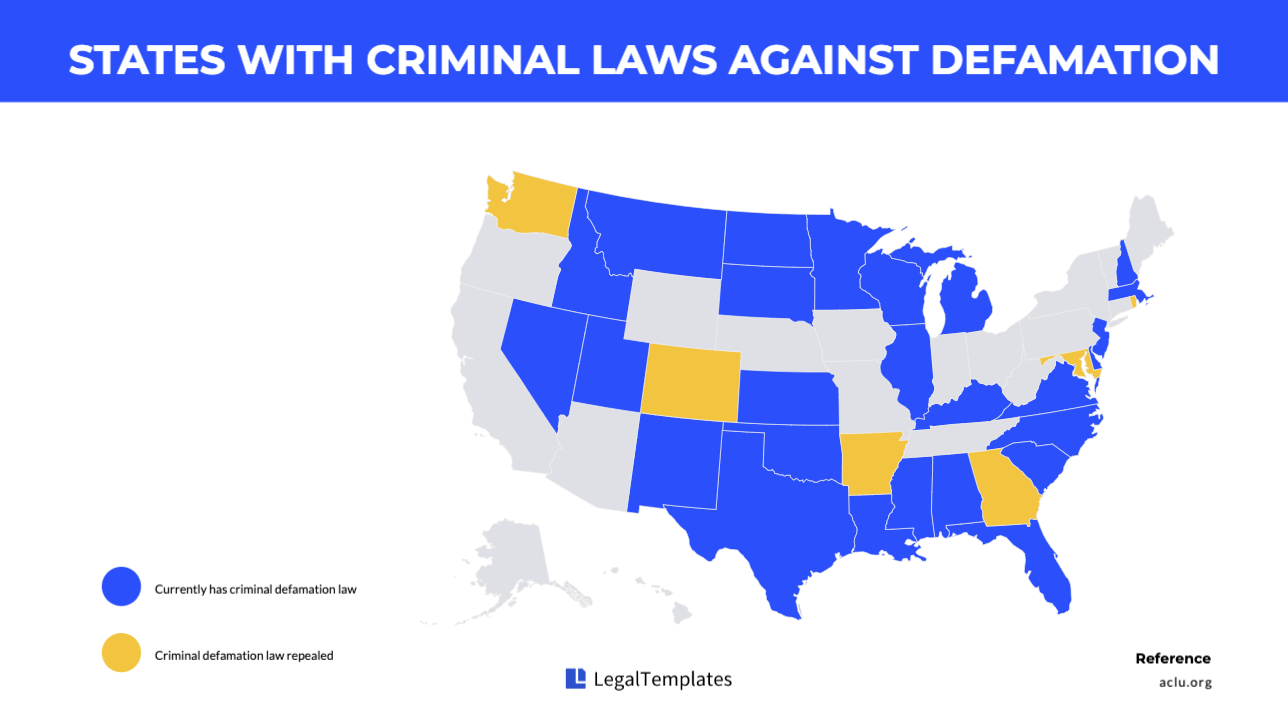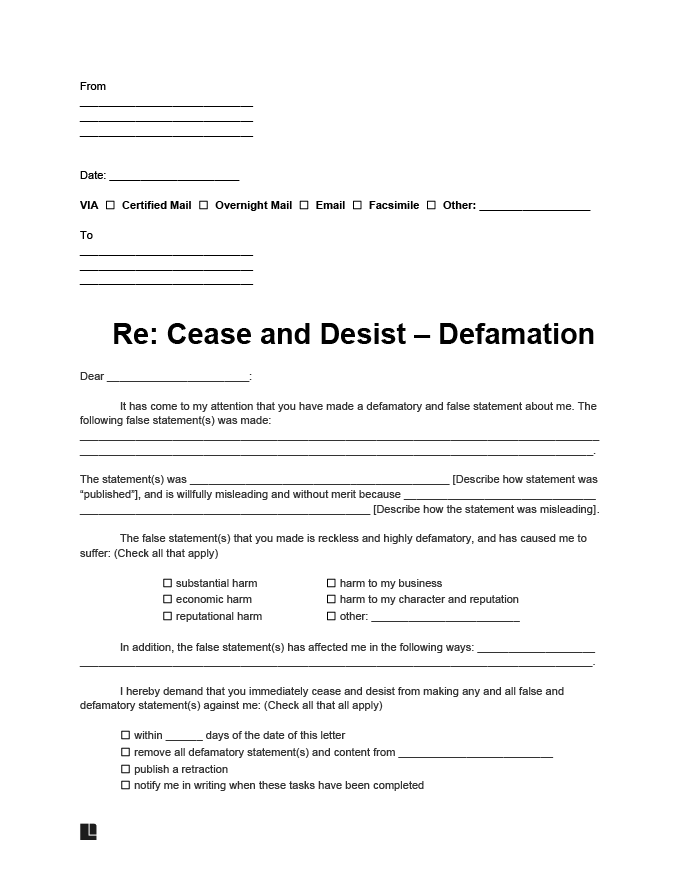A cease and desist defamation letter is a document you write to someone requesting them to stop making spoken (slander) or written (libel) statements that damage your reputation. Upon receipt of this letter, the violating party must immediately stop making false statements, remove published false statements, or face potential legal action.
About Slander and Libel
Slander involves spoken defamatory statements, while libel pertains to written or printed defamatory statements.
Federal Definitions
The term “defamation” means any action or other proceeding for defamation, libel, slander, or similar claim alleging that forms of speech are false, have caused damage to reputation or emotional distress, have presented any person in a false light, or have resulted in criticism, dishonor, or condemnation of any person.
Libel is a method of defamation expressed by print, writing, pictures, signs, effigies, or any communication embodied in physical form that is injurious to a person’s reputation; exposes a person to public hatred, contempt, or ridicule; or injures a person in their business or profession.
Why Use a Cease and Desist Defamation Letter?
Sending a letter to cease and desist defamatory statements can provide several benefits when it comes to halting defamatory statements:
- It can stop the violating party from making new defamatory comments.
- It can encourage the violating party to delete or retract existing defamatory comments.
- It can help you avoid taking someone to court by letting the offender know the statements are falsely damaging.
- It can serve as evidence to show you asked the offender to stop or retract defamatory statements if you take your case to court.
Is a Cease and Desist Defamation Letter Legally Enforceable?
No, a cease and desist defamation letter isn’t legally enforceable. The letter’s sole purpose is to warn the offender that you may take legal action if they don’t stop defaming you. Ideally, the letter will intimidate them into stopping their behavior before taking legal action, saving you time, money, and stress.
What Are the Types of Defamation?
The first type of defamation is per quod, meaning the plaintiff can prove quantifiable damages.
The other type of defamation is per se, meaning that you don’t have to prove the damages that a statement caused if the statement alleges that someone:
- committed a crime,
- has a “loathsome or contagious disease,”
- engaged in sexual misconduct, or
- did something unfit for their business, trade, or profession.
If you’re being faced with defamatory statements, a cease and desist letter for defamation is a good place to start. It can put a stop to the defamatory statements or help you provide further evidence if you have to go to court.
How to File a Defamation Lawsuit
Follow these steps to file a defamation lawsuit:
Step 1 – Collect the False Statements

Begin by collecting the false statements made against you. If the statements are online, you can gather screenshots and store them in your records before the violating party deletes them. You can also save any false statements made against you by keeping copies of written statements in publications like newspapers or magazines.
Step 2 – Show the Statements’ Inaccuracies

Find a way to show that the statements are inaccurate. For example, if someone is claiming that you’re a criminal, you can refer to public records that show a clean criminal history.
Step 3 – Write Your Cease and Desist Defamation Letter

Write this letter to inform the violating party of the false statements they’ve made. Include the following elements in your letter:
- The false statements made
- Where the false statements were published
- The damages the false statements caused
- The desired process for stopping the defamatory comments
Sometimes, this letter may be enough to stop the violating party from making damaging claims. In other instances, this letter can simply stop the violating party from making further defamatory comments until the plaintiff can take the violating party to court.
Step 4 – Claim Damages

Before you file a civil complaint, you can claim damages. In most cases, the plaintiff won’t be able to attribute a monetary value to the damages inflicted, so they can refer to the outcomes of similar past cases to estimate the damages.
Step 5 – Prepare and File the Lawsuit

Once they’ve estimated the damages, the plaintiff can proceed with filing their defamation lawsuit. Depending on where they live, the plaintiff can bring the case to a court within the proper jurisdiction.
An attorney can handle the case at this point. They’ll notify the defendant within a certain period before they officially file the case in the district court.
Defamation Laws by State

In 24 states, it’s illegal to make derogatory statements about individuals in public. The penalties against this can include fines or jail time.
Before filing a defamation lawsuit, it’s crucial to check the statute of limitations in your state. Each state has its own timeframe for pursuing such claims, typically ranging from one to two years.
Keep in mind that the statute of limitations begins when the defamatory content is first published, regardless of when you discover it. For example, if you find defamatory content three years after it was published, and your state’s statute of limitations is two years, you won’t be able to file a defamation lawsuit.
| State | Statute of Limitations | Laws | Per Se State |
|---|---|---|---|
| Alabama | 2 years | § 13A-11-163 | Yes |
| Alaska | 2 years | AS 21.36.070 | Yes |
| Arizona | 1 year | ARS 20-445 | Yes |
| Arkansas | 1 year | 660 S.W.2d 933 | Yes |
| California | 1 year | CIV 46 | Yes |
Cease and Desist Defamation Letter Sample
Review our cease and desist defamation letter template so you can write your own. You can download it as a PDF or Word file below:

